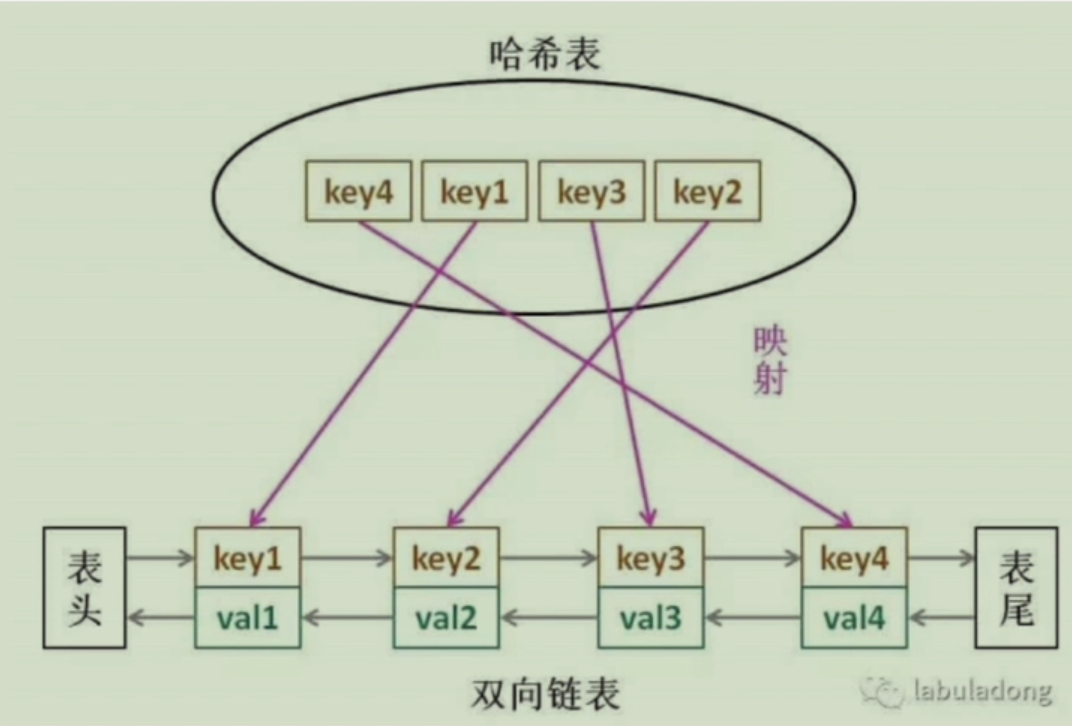# 9. LRU Cache的实现、应用和题解

# 思路
- 数据被读取了,就是被使用了,所在的位置要刷新,移动到“顶部”。
- 写入数据时:
- 之前就有的,更新数据,刷新位置。
- 之前没有的,有位置就直接写入,没有位置,就先删掉最久没有使用的条目,再写入。
- 题目说 get 和 put 都要是 O(1)O(1),这俩操作都可能导致条目的移动,这包含删除操作,所以删除操作也要是 O(1)O(1)。
# 选择什么数据结构?
- O(1)O(1) 的数据快速查找,就哈希表了。
- 光靠哈希表可以吗?
- 哈希表是无序的,无法知道里面键值对哪些最近访问过,哪些很久没访问。
- 快速删除,谁合适?
- 数组?元素的插入和移动是 O(n)O(n),删除元素也是 O(n)O(n)。不行。
- 单向链表?删除节点需要访问前驱节点,只能花 O(n)O(n) 从前遍历查找。不行。
- 双向链表,结点有前驱指针,删除和移动节点都是指针的变动,都是 O(1)O(1)。
# 双向链表、哈希表,存什么?
- 链表结点:存 key 和 对应的数据值。
- 哈希表的存在,就是为了快速访问到存储于双向链表的数据:
- key:存双向链表中存的 key
- value:存链表结点的引用。
# 定义 ListNode
class ListNode {
constructor(key, value) {
this.key = key
this.value = value
this.next = null
this.prev = null
}
}
# 定义 LRUCache
class LRUCache {
constructor(capacity) {
this.capacity = capacity // 缓存的容量
this.hash = {} // 哈希表
this.count = 0 // 缓存数目
this.dummyHead = new ListNode() // 虚拟头结点
this.dummyTail = new ListNode() // 虚拟尾节点
this.dummyHead.next = this.dummyTail
this.dummyTail.prev = this.dummyHead // 相联系
}
}
# 设计 dummyHead 和 dummyTail 的意义
- 虚拟头尾节点,不存数据,只是为了让真实头尾节点的操作,和其他节点一致,方便快速访问头尾节点。
- 初始还没有添加真实节点,要将虚拟头尾节点联结在一起。
# get 方法实现
- 哈希表中找不到对应的值,则返回 -1。被读取的节点,要刷新它的位置,移动到链表头部
get(key) {
let node = this.hash[key] // 从哈希表中,获取对应的节点
if (node == null) return -1 // 如果节点不存在,返回-1
this.moveToHead(node) // 被读取了,该节点移动到链表头部
return node.value // 返回出节点值
}
- moveToHead方法实现
moveToHead(node) {
this.removeFromList(node) // 从链表中删除节点
this.addToHead(node) // 添加到链表的头部
}
removeFromList(node) {
let temp1 = node.prev // 暂存它的后继节点
let temp2 = node.next // 暂存它的前驱节点
temp1.next = temp2 // 前驱节点的next指向后继节点
temp2.prev = temp1 // 后继节点的prev指向前驱节点
}
addToHead(node) { // 插入到虚拟头结点和真实头结点之间
node.prev = this.dummyHead // node的prev指针,指向虚拟头结点
node.next = this.dummyHead.next // node的next指针,指向原来的真实头结点
this.dummyHead.next.prev = node // 原来的真实头结点的prev,指向node
this.dummyHead.next = node // 虚拟头结点的next,指向node
}
# put 方法实现
- 写入新数据,先检查容量,决定是否删“老家伙”,然后创建新的节点,添加到链表头部(最不优先被淘汰),映射到哈希表。
- 写入已有的数据,则更新数据值,刷新节点的位置。
put(key, value) {
let node = this.hash[key] // 获取链表中的node
if (node == null) { // 不存在于链表,是新数据
if (this.count == this.capacity) { // 容量已满
this.removeLRUItem() // 删除最远一次使用的数据
}
let newNode = new ListNode(key, value) // 创建新的节点
this.hash[key] = newNode // 存入哈希表
this.addToHead(newNode) // 将节点添加到链表头部
this.count++ // 缓存数目+1
} else { // 已经存在于链表,老数据
node.value = value // 更新value
this.moveToHead(node) // 将节点移到链表头部
}
}
- removeLRUItem 方法实现
removeLRUItem() { // 删除“老家伙”
let tail = this.popTail() // 将它从链表尾部删除
delete this.hash[tail.key] // 哈希表中也将它删除
this.count-- // 缓存数目-1
}
popTail() { // 删除链表尾节点
let tail = this.dummyTail.prev // 通过虚拟尾节点找到它
this.removeFromList(tail) // 删除该真实尾节点
return tail // 返回被删除的节点
}
# 整体代码
class ListNode {
constructor(key, value) {
this.key = key
this.value = value
this.next = null
this.prev = null
}
}
class LRUCache {
constructor(capacity) {
this.capacity = capacity
this.hash = {}
this.count = 0
this.dummyHead = new ListNode()
this.dummyTail = new ListNode()
this.dummyHead.next = this.dummyTail
this.dummyTail.prev = this.dummyHead
}
get(key) {
let node = this.hash[key]
if (node == null) return -1
this.moveToHead(node)
return node.value
}
put(key, value) {
let node = this.hash[key]
if (node == null) {
if (this.count == this.capacity) {
this.removeLRUItem()
}
let newNode = new ListNode(key, value)
this.hash[key] = newNode
this.addToHead(newNode)
this.count++
} else {
node.value = value
this.moveToHead(node)
}
}
moveToHead(node) {
this.removeFromList(node)
this.addToHead(node)
}
removeFromList(node) {
let temp1 = node.prev
let temp2 = node.next
temp1.next = temp2
temp2.prev = temp1
}
addToHead(node) {
node.prev = this.dummyHead
node.next = this.dummyHead.next
this.dummyHead.next.prev = node
this.dummyHead.next = node
}
removeLRUItem() {
let tail = this.popTail()
delete this.hash[tail.key]
this.count--
}
popTail() {
let tail = this.dummyTail.prev
this.removeFromList(tail)
return tail
}
}